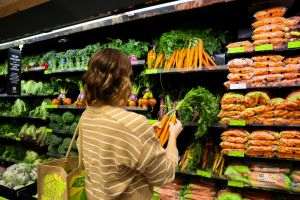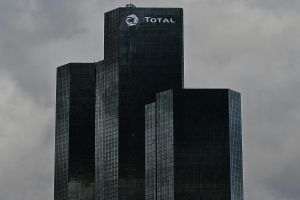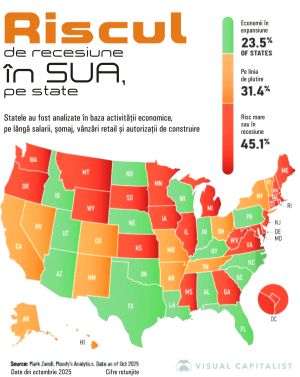• KeysFin: Romanian agriculture - turnover of 8 billion Euros
• Record result - set back, however, by the major issues of the sector of animal growth
• Baciu, LAPAR: "Next year's wheat, barley and rapeseed harvests - compromised because of the draught"
This year, Romania is seeing the best agricultural result in its history, according to experts. The record wheat and corn production places the agriculture turnover to almost 8 billion Euros, according to analysts of KeysFin.
Data from the Ministry of Agriculture shows that wheat production this year is 200,000 tons bigger than last year, surpassing 10 million tons, and that of corn would be in the range of 14.5 and 15 million tons, compared to just 11.8 million tons that France will harvest. This means that Romania will become the biggest European producer of corn, according to the estimates of the General Association of Corn Producers (AGPM). Also in barley and two-row barley, Romania had a greater output than last year.
Agriculture minister, Petre Daea, confirms that we will be first in the European Union when it comes to the corn harvest. The official also stated on several occasions that Romania this year has had, this year, record harvests of wheat, corn and sunflower. In his opinion, "Romania was, is and will remain one of Europe's grain powers", because it has extraordinary conditions of climate and soil to achieve high crop yields.
The net historical outputs of the agricultural sector have led to a drop in the price of grain, according to Laurenţiu Baciu, the president of the League of Associations of Romanian Agricultural Producers (LAPAR). According to him, while in the beginning of the year, the price of one kilo of sunflower was 1.3 lei in the beginning of the year, after this year's record output was announced, the price fell to 1.1-1 leu/kg. At the same time, the price of corn fell from 58-59 bani to 52 de per kg. "As for wheat, it's even more interesting, because in this period there aren't even wheat transactions being made", Laurenţiu Baciu further added.
The president of LAPAR told us that next year's crops of wheat, barley and rapeseed are compromised, stating: "Because of the drought, we have a disastrous situation in agriculture. In order for a grain harvest to survive the winter, it needs to meet a few requirements, usually by October 15th. On the other hand, so far, these crops have not even sprung. Even if that were to occur tomorrow, they are compromised, they won't withstand the winter. In my opinion, we will only make 2000-3000 kg per hectare, which means the covering of just 40% of the expenses".
• The spectacular performance in agriculture is owed to the major investments in the sector
According to analysts from KeysFin, the spectacular performance in the agricultural sector is owed to the major investments in this sector: "Significant investments have been made in the optimization of the production flows, from using efficient seeds to the streamlining and modernization of the works for the maintenance of crops and mechanized harvesting, including through satellite monitoring. From many points of view, Romanian agriculture has taken huge steps towards modernization, and the effects are visible in the harvests that are growing year after year".
The quoted sources state in Romanian agriculture there are currently approximately 12,727 companies specializing in the growing of plants which have generated last year over 64% of the total turnover in agriculture.
We also have over 3,247 companies (29% of the total turnover) involved in animal raising, and 1272 companies operating in mixed agricultural activities, which ensure 7.6% of the total agricultural business.
According to KeysFin data, agriculture business has increased 20.7% in 2017 over 2013 and up 6.8% over 2016, to 35 billion lei. For the current year it is estimated it will surpass 36 billion lei.
"The excellent results in output in wheat and corn could contribute significantly to this record result, which is set back, however, by the major problems in the stockbreeding sector, where the swine flu has significantly affected the businesses of producers and distributors", experts say.
These state that aside from the swine flu crisis, the interest in agriculture is rising among investors. The number of companies has increased over 7% compared to 2013, to 17,246. Moreover, in the first seven months of 2018, 1,450 new companies were created (with an increase of 27% over the similar period of 2017), but almost 6,500 have disappeared, a 33% increase over the first months of 2017.
The quoted sources show: "The Romanian agriculture is in full process of consolidation, as evidenced by the fact that over the last 2-3 years, many mergers and acquisitions have taken place. There are mainly foreign investors, who have acquired major areas of land and farms, providing the logistical support which has allowed the development of these record crops, in spite of the draught problems".
Experts warn that even though overall the evolution of the sector is a positive one, the conclusion of a service contract, or for the acquisition of seeds, fertilizers, maintenance services, etc. can generate a financial deadlock to the extent where companies don't inform themselves enough about their business partners: "During the contract signing stage, for the establishment of the payment terms, it is essential to consult creditworthiness and/or group reports prior to granting commercial credits and establishing the payment terms. And in the post-signing period becomes necessary the monitoring of customers using various sources, from the Payment Incidents Bureau, to the data in the Bulletin of Insolvency Proceedings, the changes of shareholders and administrators etc.".
The number of employees in agriculture has increased 6% over 2013, to 85,400, but has decreased 2% over 2016. What is interesting is also the fact that in 2017, the median cost per employee has increased far quicker than labor productivity, up 63.4% over 2013 and 18% over 2016, to 3,540 lei per employee. Labor productivity in this sector has seen, last year an increase of 14% over 2013 and 9% over 2016.
In agriculture, just like in the other areas of the economy, the acute shortage of workers is making itself felt. In this context, an increasing number of companies have bet on integrated solutions, as the process for the retooling of agriculture became even deeper, analysts explain.
• The biggest agricultural businesses in Romania - in Timiş, Călăraşi, Constanţa, Buzău and Satu Mare
According to data by KeysFin, the biggest businesses in the Romanian agriculture are made in the counties of Timiş (2.85 billion lei), Călăraşi (2.54 billion lei), Constanţa (1.93 billion lei), Buzău and Satu Mare (with businesses of 1.6 billion lei each).
The chart of the cultivators is led by Agro-Chirnogi SA, with turnover of 880.6 million lei in 2017. That company is followed by Promat Comimpex SRL (541.5 million lei), Plantagro-Com SRL (439.7 million lei), Agricost SA (359.2 million lei) and Wine Solutions Network SRL (284.2 million lei).
Among the top 5 animal breeders, Smithfield Romania SRL is ranked first, with turnover of 920.1 million lei, followed by Transavia SA with 531.5 million lei, Agrisol International SRL (291.5 million lei), Avicola Buzău SA (264.3 million lei) and Avicarvil SRL (159.3 million lei).
• Difficult access to funding - one of the challenges of the agricultural sector
The agricultural sector is not exempt from challenges, which begin with the difficult access to funding and the effects of the financial deadlock. Thus the number of insolvent companies in the sector has increased over 15%, to 389 companies in the first months of 2018, which is a sign that many companies do not have the financial resources to withstand the difficulties in the financial chain, according to the quoted sources.
The KeysFin analysis shows that after industry and mining industry, agriculture is the third sector in terms of the median length of time of the current debts (297 days in 2017), far over the average of the economy (161 days in 2017).
Also, agriculture is ranked third after professional activities and construction, when it comes to the median collection period (165 days in 2017), again above the median of the economy (90 days in 2017).
KeysFin say: "There are signs that many companies, especially SMEs in this sector, are acutely suffering from underfunding. Commercial debts have increased 37% over 2013, to 13.3 billion lei in 2017. What is relevant is also the fact that the outstanding debts to suppliers have increased 8.8% compared to 2013, to 3.66 billion lei. Out of that amount, over 1.44 billion lei represent arrears of more than one year, which mean 54% of the total, compared to just 40% in 2013. At the same time, the weight of the invoices not paid over a period of 30 days has fallen from almost 25% in 2013 to 12%, meaning 327 million lei in 2017".
• KeysFin: "40% of the agricultural surfaces are in areas at risk of desertification"
According to UN data, whereas in 1960 the cultivated surface of a hectare of land would feed two people, in 2030, that same surface would have to feed 5 people.
Since the population of the world is growing every day by 200,000 people, by 2050 the agricultural production will have to increase 70-100% to feed those over 9 billion people globally.
Intensive cultivation, using technologies that use the potential of the soil to the maximum, needs to be looked at very carefully, according to the analysts of KeysFin, who mention: "In a previous analysis we talked about the fact that the limitless exploitation of lands could significantly affect the fertile agricultural surface, as there is a very major risk of desertification".
The evolution of the turnover in the agricultural sector proves that Romania has significant potential, and the future looks great for this sector.
Experts are saying that under these circumstances, there is obviously need for modern technologies and solutions to fight pests, diseases and weeds, especially as the pressure of the climate factors on the agricultural ecosystems is increasing. In order to stay competitive, Romanian farmers need to resort to the latest technologies and solutions.
"We need to avoid the temptation to produce a lot, by ignoring the possible effects on the environment and the ecosystems. We need a responsible agriculture, which would remain profitable to the future generations as well", the quoted experts say.
Agriculture is currently using 70% of the global resources of drinkable water, and 40% of the world's agricultural surface is suffering from the effects of erosion. UN data shows that every second, we are losing an agricultural surface equivalent to the loss of a football land, and until 2050 four billion people will be living in countries with a water deficit.
Romania isn't exempt from the danger of desertification. According to data from the Pedological Studies Office, over 1000 hectares are covered by sand every year, with the erosion and desertification process being the most visible in Southern of the Romanian Field, Dobrogea and Southern Moldavia.
And the IPCC data (the Intergovernmental Committee for Climate Change) shows that one third of Romania's territory, approximately 7 million hectares, and 40% of the agricultural land are located in areas at risk of desertification.
Last year, Romania reported a total output of grain of almost 27 million tons, with historic highs in wheat, peas, barley, sunflower, soy, corn, potatoes and grapes. The production of wheat, rye and triticale was about 10 million tons, with a yield of 4.83 tons per hectare, whereas in corn the crop "jumped" to 14.5 million tons, with a median yield of almost 6 tons per hectare. In sunflower as well there has been a record harvest, of 3.167 million tons in 2017, with a yield of 2.72 tons per hectare. According to the statistical data, among EU member states, in 2017 Romania was ranked first when it comes to sunflower, (based on the cultivated surfaces and the output), and first in and corn in terms of the cultivated surface and second in terms of the output, following France.




























































